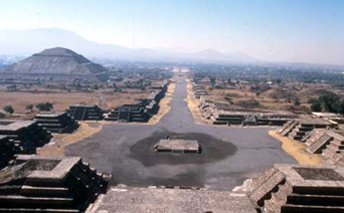
Pyramid of the Moon with Cerro Gordo, Teotihuacán, Mexico. c. 150-225 C.E.
A history of landscape design is necessarily a history of human culture. It should be located in the broadest sense in relation to values of time and space, but also more specifically as an art historical pursuit, seeking to demonstrate how philosophical concepts, and not only ideals of beauty, are expressed through art — in this case, an art that modifies and shapes nature. A history of landscape design is one way of writing the history of the human mind. Therefore, while this book seeks to provide a description of the designs of specific locales, the approach is contextual. It attempts to portray landscapes as products of attitudes toward the cosmos, nature, and humanity and to show how they share elements of form and meaning with artifacts from the disciplines with which they are most intimately, and often inextricably, allied — painting, sculpture, architecture, and the decorative arts — as well as with literature and other means of ideological expression. It is thus a narrative of a relationship between human beings and their world and of their attempts to invest nature with purposeful order and meaning and specific places with expressive form and heightened significance.
The mores that stem from people’s attitudes in each age and geographical region are manifested in myths, rituals, social structures, and economic pursuits. These things affect the organization of space and the design of forms within it, which in turn rationalize and institutionalize patterns of cultural behavior. In speaking of a prevailing cultural consensus, however, one must offer qualifications. The decisions of governing elites, planners, architects, and landscape designers as well as those of the builders of vernacular structures for practical purposes and everyday use occur within social contexts in which there is often a historical lag between the articulation of philosophical ideas and the creation of forms that manifest those ideas. Contrarily, a philosophy yet to be expressed may be anticipated by a physical manifestation. In both cases, a gap between ideas and cultural expression is apparent. But whether it anticipates or confirms them, design does reflect certain normative cultural values, including those articulated by philosophers when they offer their particular intellectual lenses through which to perceive the cosmos and the place of human beings within it.
Many of the landscapes discussed in this book have now vanished. Others can be mentally or physically reconstructed only from the clues offered by archaeologists. Some are mere relics of their original designs. Certain landscapes, on the other hand, show an amazing persistence over time. Still others — the world’s fair, the theme park, the shopping mall — are products of the present era. All can be interpreted as expressions of cultural values. Moreover, because landscapes have a temporal dimension, altering with time, they can be read as palimpsests, documents in which nature’s own powerful dynamic and the changing intentions of human beings over the years inscribe a historical record.
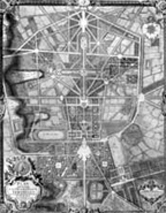
Plan of 1710 by Pierre Le Pautre of the palace, gardens, and town of Versailles.
Since culture is always both a cause and effect of particular political, economic, and technological circumstances as well as of cosmological and philosophical attitudes, each age and country leaves its own legacy, signifying in large measure its type of governance, degree of wealth, and level of construction skills, as well as its political character and religious beliefs. All of these things are given form through the tastes and talents of patrons and designers. Indeed, the tastes of patrons and the talents of designers could not be exercised in the same manner, nor would the style and iconographic content of their work be as it is, in the absence of particular combinations of governance, wealth, and technology as informed by philosophical thought. By way of example, one may say that work of the great seventeenth-century French landscape designer André Le Nôtre expresses the authoritarianism of Louis XIV’s regime, the prosperity of the French economy under the management of the finance minister Jean-Baptiste Colbert, the development of new means of constructing earthworks by the military engineer Sébastien Le Prestre de Vauban, and the application of the mathematical philosophy of René Descartes to the art of landscape design. To say this does not diminish our estimation of Le Nôtre’s genius; it merely furnishes the conditions and parameters of its flowering.
It should be stressed that to understand designed landscapes, as well as human attitudes toward natural ones, one must venture beyond the important areas of political, economic, and technological history into the realms of cosmology, religion, science, and metaphysics. The physical world, as shaped by thought and action, mirrors the human mind as a theater of myth, ritual, allegory, and reason. So, too, the mind’s capacity for sensation and reflection finds expression in the shaping and furnishing of landscape space, as does the human desire for public ceremony and personal pleasure. This book traces the flow of these mental energies across time and space, examining the cultural matrices of various periods and places and the influence of these upon landscape design.
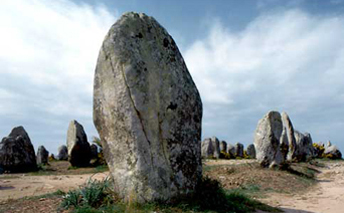
Menhirs, Carnac, France. 3rd millenium B.C.E.
Landscape and religion bore a particularly close relationship to one another in prehistoric times and early antiquity when people perceived nature and the cosmos to be pregnant with spirit forces, which they personified as gods governing the hunt and later the fertility of the soil and the harvest.
Aware of the degree to which their lives were subject to the forces of nature, prehistoric and ancient societies developed rituals of propitiation to ensure seasonal benefits, such as bountiful game, adequate rainfall, and the warmth of the sun as well as the continuation of human life through successful reproduction. The spaces in which these ceremonies took place were theaters for religious expression within a larger landscape. This is the lesson of Paleolithic cave art and the astronomical alignments of the stones at Stonehenge and other megalithic circles. The cosmological orientation found in the archaeological remains of temples, platforms, and pyramids in Egypt, Mesopotamia, India, Crete, Greece, and the Americas implies a similar conclusion. In such ruins, one sees how human beings expressed in landscape terms their alliance with spirit forces within the earth and how they invoked the aid of cosmic powers. There is a reciprocity between the human and the natural that honors the notion of an inherent divinity in both. Sacred sites — mountains, lakes, and springs — called out to these early peoples. Pyramid, ziggurat, kiva, mound, and temple — these were ceremonial sites, as Puebloan plazas still are.
The transformation of religion from the worship of animal spirit, sun, and Earth Mother to that of a pantheon of deities presided over by Zeus and Apollo can be read in a selection of sacred landscapes. Ancient classical temples and their siting in the landscape reveal how Greek logic and mathematics began to transform the human bond with nature from one belief system to another. Blood sacrifice, ritual dancing, and oracular consultation as a means of invoking the cooperation of unseen forces in a precarious world did not disappear with the dawn of the Greek Classical age in the fifth century B.C.E. But alongside these practices, Greek philosophers proffered another means of shaping destiny. Reliance upon the powers of intellect in the affairs of humankind slowly assumed at least equal importance with dependence upon the forces of fate. Landscape, although still the province of propitiatory rites, was manipulated in ways that suggest a new sense of confidence in reason. This is evident on the Athenian Acropolis, where the defensible site of the earlier city, after being devastated by the Persians, was rebuilt in the fifth century B.C.E. as a religious precinct in which an architecture based upon exquisite mathematical proportions is worn like a proud crown.
The power of empire and the pride of Caesars invested Hellenistic and Roman landscapes with characteristic forms of spatial composition, as well as with a more cosmopolitan and secular approach to design. Colonial cities were rationally laid out in grid plans, and imperial largesse was expressed in aqueduct-fed baths and fountains as well as in basilicas, arenas, and theaters. Unlike the expression of power in Baroque plans of the seventeenth and later centuries as a centrifugal force of axes radiating outward in an apparent act of dominion, the ancient Roman city represented a centripetal gathering of energies into enclosed spaces: the town itself, the forum, and the inward-focused peristyle garden. The ubiquitous reiteration of prototypical elements of Roman urbanism — forums, basilicas, baths, theaters, arenas, libraries, roads, triumphal arches, aqueducts — in cities linked by a vast road system throughout the Mediterranean world was a demonstration of imperial might.
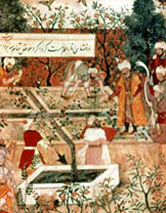
Babur Giving Instruction for the Layout of Bagh-i-Vafa, from a Mughal miniature, one side of a double page from the Babur Nama, c. 1590, Ms. I.M. 1913.276A, 276 Victoria and Albert Museum, London. Here the Mughal emperor is superintending the building of a garden at Kabul.
The elements of myth and ritual were elaborated as allegory in Roman times. For instance, the cave sanctuary in nature was symbolized in the artificial grotto where it served as a psychological echo chamber, a place where the human psyche found a physical link to the prehistoric world of the Earth Goddess and nature spirits. Grottoes with sculptural representations of nymphs and other subterranean spirits were installed in many villa gardens, one of the most spectacular of which was that built by the emperor Hadrian. Throughout its vast, now mostly vanished, decorative program of sculpture, wall painting, and mosaic, Hadrian’s Villa also provides an early example of the associative garden, or the thematic treatment of landscape in which allegory plays a role.
Christians and Muslims appropriated allegory in the recurring metaphor of paradise as a garden in literature and art. The gardens of both cultures exploited the symbolic relationship of landscape and heavenly reward. Four watercourses in Islamic gardens and four paths leading from a central fountain in Christian ones represented the four paradisaical rivers mentioned in the Quran and the Bible. The cool, sparkling, reflective, murmurous qualities of water in these gardens were particularly conducive to otherworldly contemplation and well suited to the image of paradise as a place of tranquil refreshment and beauty.
Allegory also plays a strong role in Renaissance and Mannerist gardens where the myths of antiquity were revived and reinterpreted by humanist scholars. At the Villa d’Este, for example, to manifest the beneficence of the owner, Cardinal d’Este, much of the garden’s sculptural iconography was associated with the virtuous hero Hercules. Here and at the Villa Lante, the hunting park and country estate of Cardinal Gambara, are found symbols celebrating each cardinal’s ability to fructify the land through a combination of art and nature. The use of allegory to glorify popes and princes can also be recognized in many seventeenth- and eighteenth-century gardens, as at Versailles where the abundant symbols of Apollo, the sun god, refer to Louis XIV.
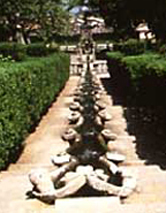
Water Chain, Villa Lante, Viterbo.
Along with this last, late use of allegory, another development was occurring that has affected the modern worldview and, with it, the approach to landscape making: the birth of systematic science and the greatly increased reliance upon reason as a governing principle in the affairs of life. The shift from belief in an earth-centered, self-contained, closed universe to a boundless one, and the consequent opening of the human mind to new metaphysical possibilities, had a profound effect on philosophy. This unharnessing of the intellect from ancient constructs found parallel physical expression in the treatment of space in landscape design. The garden remained enclosed and by definition a place set apart from its cultivated rural surroundings and wild nature (the garden being characterized since the Renaissance as “third nature,” as distinguished from the agrarian landscape — “second nature” — and wilderness — “first nature”), but it no longer represented itself as an enclosed space, and its axes were given apparent elongation, as if to join the actual horizon. Le Nôtre’s plan of the Sun King’s gardens at Versailles is thus as much an expression of the opening of the mind to a new heliocentric interpretation of the universe, which was then considered coterminous with our galaxy, as it is of the confidence, optimism, and pride of France during the first half of the reign of Louis XIV.
Axial extension within the garden, in turn, provided a paradigm for city planning. This form of urbanization following the layout of the town and gardens of Versailles, the international model for new and modernizing cities, involved the construction of wide straight thoroughfares, often radiating from a prominent monument, prestigious structure, or central public space to the far reaches of the urbanized mass and even into the countryside. During the eighteenth, nineteenth, and early twentieth centuries, governments sponsored grand axial plans with broad avenues and magnificent architecture and sculpture as a means of expressing their power and authority, providing better police protection, and facilitating military control of rebellious mobs. In addition, the grand thoroughfares of the monumental city served the elite for whom the invention of the lightweight, spring-hung carriage had made vehicular promenading an important social pastime. Also toward these ends, ancient and medieval town walls were torn down and converted into boulevards. This occurred first in France where the birth of the modern nation-state rendered obsolete the enclosed fortified city.
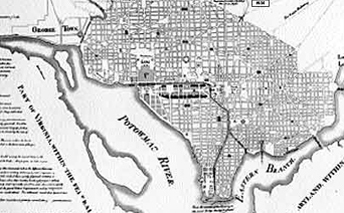
Plan of Washington, D.C. (detail). Designed by Pierre Charles L’Enfant. 1791.
As Isaac Newton was solidifying the basis of the Enlightenment and confirming the role of reason in human thought, John Locke asserted that all knowledge of the world must rest on sensory awareness. This concept of the mind as an instrument for inductive reasoning and a theater for personal experience, rather than as a receptacle for revealed Truth and immutable law, helped change the character of landscape design in the eighteenth century. Respect for the potential of landscape to produce mental sensations through association caused garden designers to gather into their repertoire of effects images of a poetic and painterly nature, especially at first those that evoked the antique past through classical forms and pastoral Arcadian motifs. The garden became no longer a stage for the display of power, an arena of social interaction, but a place for solitary or companionable reflection and contemplation. Locke’s philosophy thus provides a key for those who would ponder the meaning of miniature temples, sham ruins, grottoes, and grazing deer in an eighteenth-century English landscape park.

Garden of Tenryu-ji Temple, Kyoto, rock arrangement suggesting Penglai (pronounced Horai in Japanese), one of the Islands of Immortals, according to Chinese legend. Kamakura Period.
Though much earlier in its origins, the East Asian garden was equally a place of poetic association and friendship. As in England, in China and Japan the associative potential of garden scenery was an important design consideration. In China, the talents of poet, painter, and garden designer were fused, often in the same persons. These artists enjoyed an especially close relationship with nature, and their compositions evoke the precipitous peaks of certain mountainous parts of their country. Derived from China, Japanese garden design is also premised upon a great deal of naturalistic rockwork, although the carefully arranged, flatter, less contorted stones in Japanese gardens understandably reflect more that country’s island scenery than the topography of its mainland neighbor. The rocks in both Chinese and Japanese gardens are replete with symbolical associations. Plants, too, enjoy a symbolic function, and appreciation of selected species, such as peonies, chrysanthemums, plum trees, and bamboo is focused and intense.
In the late eighteenth century, pathos and memory came to play an important role in Western garden design as Romanticism replaced classical order as the dominant cultural impulse of Western civilization. Jean-Jacques Rousseau’s belief in the importance of commonly accessible personal experience in nature and in the virtues of a democratically organized citizenry had important consequences for landscape design. Gradually, the focus of Lockean sensation was transferred from the literary and political to the patriotic and personal, and the Western garden became an arena in which to honor heroes of state and a place for the repose of the dead. This accounts for the affective and often elegiac character of the Picturesque style and why it made an appropriate design idiom for the nineteenth-century rural cemetery. The popularity of Rousseau’s philosophy, which gained strength through the several revolutionary movements that enfranchised a much larger segment of the general populace during this turbulent era, helps explain the origins of the public parks movement.
Concurrent with the birth of Romanticism and the revolutionary forces growing out of it and leading to the development of nationalistic capitalist democracies and communist states, the Industrial Revolution provided the cultural dynamic that made possible the accelerating advances in machine technology that continue to propel contemporary life. Over the past two hundred years, democracy’s “right to life, liberty and happiness,” including the enjoyment of private property, has promoted personal pleasure as a powerful principle in the field of landscape design, as in other areas of life. The advances of egalitarianism have caused the continued transformation of the pleasure garden, once the exclusive domain of the aristocracy, into a recreational preserve for the masses.
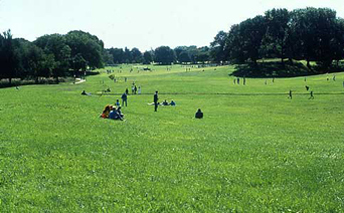
Long Meadow, Prospect Park, Brooklyn.
The Industrial Revolution profoundly altered the nature of urban life, especially as transportation advances induced a new mobility within and between cities, and time and distance assumed new meaning. Paris’s radical reorganization in the second half of the nineteenth century reflects this Machine Age transformation. The parks movement and the development of the residential suburb in America in the second half of the nineteenth century express a nostalgia for the agrarian past that was concomitant with industrialism and the growth of cities in the modern era. During this period and continuing to the present day, the market forces of a globalizing culture have promoted the eclectic character of landscape design in the West. In the absence of a general cultural consensus since at least the beginning of the nineteenth century, design has been increasingly viewed as a commodity, a mere matter of consumer taste, as expressed in the casual intermingling of various past styles.
Twentieth-century modernism attempted a radical reinvention of architectural design, with landscape architecture, somewhat hesitantly at first, joining forces in forging a highly rational, functionalist, purportedly style-free vocabulary. But in the end, as Postmodernists disavowed its doctrinaire “form follows function” aesthetic, Modernism, too, became a style, a design option rather than a mandate.

Main Street, Magic Kingdom, Walt Disney World, Orlando, Florida, designed by Walt Disney Imagineering as a replication of Main Street at Disneyland, Anaheim, California.
Catering to popular taste, the creators of world’s fairgrounds, theme parks, and shopping malls applied narratives of history and fantasy to landscape with the aid of media technology and mass-marketing techniques. The modern self-theming of cities to attract tourists is a manifestation of this trend, one in which historic preservation, in traversing the distance between reverence for the past and profitability, sometimes takes a pratfall into the realm of parody. Nevertheless, some efforts to establish serious historical meaning within the contemporary designed landscape and to preserve nature and create psychologically resonant metaphorical representations of it still manage to heighten the spiritual bond between humanity and the built and natural environments.
A comprehensive survey such as this is necessarily a dialogue across the centuries and across the globe. In tracing patterns of influence, it is apparent that form follows culture, but, once developed, form often follows form. By example, the revival of the forms of Greek and Roman art and architecture during the Renaissance and later periods of Western history exemplifies the ways in which people of other eras and in other places have found in the forms forged in antiquity an expressive design vocabulary for their own particular societal aspirations. Transmission may also occur more directly, moving along the paths of military adventure and trade, as when the formal innovations of one country are exported to, or imported by, another through conquest and assimilation.
Such was the case from the fourth through the second centuries B.C.E. as Alexander the Great’s far-flung Hellenistic empire carried Greek forms to the farthest reaches of the Mediterranean basin and beyond to Persia. Similarly, in early sixteenth-century France, the development of the French Renaissance garden was based upon direct imitation of Italian Renaissance garden principles and the immigration to France of Italian garden designers following the Neapolitan campaign of the French king, Charles VIII. But just as the Japanese assimilated Chinese garden concepts along with Buddhism beginning in the sixth century and then developed out of this beginning their own indigenous approach to garden making, so too did those who followed the French Renaissance garden designers evolve from their forms ones that were distinctive to French culture, which were subsequently adopted, adapted, and altered by others elsewhere.
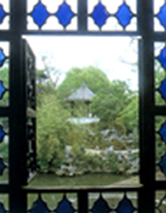
Bamboo Hat Pavilion seen through window with blue glass in Thirty-Six Mandarin Ducks Hall, Zhou Zheng Yuan (Garden of the Unsuccessful Politician), Sizhou. This 10-acre garden originated in the Ming Dynasty and was extensively repaired and expanded in the 1950s.
Traditionalism, or historicization, for its own sake, as stylistic imitation of past forms simply for the period qualities they convey and aesthetic characteristics they display, can be explained as part of a wide-spread reactionary attitude toward the Industrial Age on the part of some since the beginning of the nineteenth century. The reverse of modernism, this attempt to cherish and derive emotional satisfaction from association with what is venerable and vanishing is a strategy for denying accelerating change and the Faustian transformation of the world through technology.
Following the currents of classicism and Neoclassicism, the growth of Romanticism and the dissemination of the Picturesque style, the development of various urban planning models from the Hellenistic grid to the contemporary edge city — these are some of the tasks of a broad-based landscape history. The pursuit of these landscape design developments will enable us to see, among other things, how the inherently autocratic style of city planning favored by European monarchs in the seventeenth century could be used in laying out Washington, D.C., the capital of a new democratic nation in the eighteenth, or how the adaptation of the English Picturesque style, developed by and for aristocratic estate owners in the eighteenth century, became the paradigm for the nineteenth-century public park.
Landscape design is fundamentally a relationship between people and place, a partnership between art and nature, and, increasingly, between art, nature, and technology. Art and technology have the power to modify nature, but landscape design operates within the laws of growth and decay that govern all animate life. The mystery of nature as an independent force — bounteous and generous, overpowering and destructive — makes the experience and practice of landscape design both spiritually rewarding and scientifically challenging. Its historiography is made especially difficult by the natural tendency to view past cultures through a contemporary cultural lens. Our attempt here is to penetrate, however imperfectly, the consciousness both of human beings who are like ourselves and of those who are mentally and spiritually very different from us.
In so doing, we must stress that the separation of myth, religion, philosophy, and science into independent modes of perception, inquiry, and belief is a product of the modern mind. The compartmentalization of knowledge and the promotion of scientific rationalism as the primary mode of investigating reality and constructing a worldview in the West have devalued intimate experience and empirical knowledge. Although psychology, especially the psychology of Carl Jung, has given us insight into the collective unconscious and the role of myth and archetypes as bearers of meaning, insight is not the same thing as the wholehearted belief that integrates all social purpose — religious, political, economic, architectural — in a holistic way as it did for some prehistoric and ancient societies, as well as for later ones that subscribed to the ideals of Christianity, humanism, rationalism, or other widely shared systems of thought.
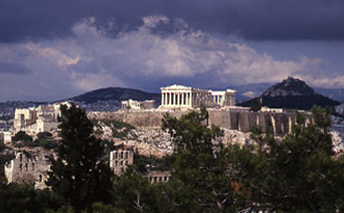
The Acropolis, Athens.
Today we are both exhilarated and disquieted. We thrill to the boons of technology and the adventure of the Information Age in which we are taking part, and yet we experience anomie and the psychological dis-location of an increasingly migratory way of life. The ease of replication within industrial capitalist economies fosters mimesis of time and space whether in the form of “historic” villages, theme parks, malls, restaurants, resorts, or museum reconstructions. These environmental simulations of the long ago and the far away, as well as the purely fantastic, aided by photography and cinema, are now universally marketed and displayed to mass audiences. A kaleidoscope of juxtaposed, heterogeneous images of place is also made accessible by the Internet. The ease with which images of period and place are now distributed has the effect of commercializing the original prototypes, turning them, where they still exist, into famous clichés and tourist icons.
The term urban sprawl has gained currency and disapprobation because we have invented a new kind of city, amorphous and without the mythic, religious, or even political foundations that cities have historically enjoyed. Business chains and franchise operations proliferate along commercial strips, transforming the locally particular into the repetitiously familiar. This may give the brand-name consumer and mobile traveler assurance, but the increasingly predictable, homogeneous, loosely urbanized environment equally induces boredom and — in a very prosaic and literal way — déjà vu.
As accelerating mobility and speed of communications continue to shrink distance and collapse time, place becomes increasingly provisional and temporary. Increasingly rootless, we articulate concepts valorizing community. This is so because humans are in a fundamental way place-making animals, revealing in this act their individual and collective dreams. The landscapes that we create are combinations of artifice and nature, and in designing them people of every period have revealed a great deal about their cultural values while demonstrating the perennial exigencies of life and our universal need for water, food, and shelter. Perhaps as we reanimate our spiritual selves, develop new culturally sustaining myths, and reunite science with religion and philosophy, we will be able to create places that are life-sustaining in a truer sense than now. For, as the twentieth-century French philosopher Gaston Bachelard posited, when we examine space in terms of psychology and phenomenology we find that we are still place-bound creatures, carrying in the recesses of our memories personal histories of spaces we have inhabited and imagined. Further, we carry “placeness” in our genes and in our sensory apparatus as human animals, and because biological nature is still the matrix of our existence we long to feel at one with the natural world.
It is not surprising that the origins of the Romantic movement and the romanticization of nature and of prehistoric and aboriginal peoples as “noble savages” were concurrent with the Industrial Revolution. Machine technology has introduced into the world an enormously potent, self-referential set of systems that affect us in ways that are at the same time obvious and incomprehensible. “The machine in the garden,” to borrow the metaphor of Leo Marx for the uneasy alliance of technology and nature, has taken up permanent residence in human consciousness, and perhaps without realizing that this is occurring, we may be witnessing the moment in Western history when industrial technology becomes affirmatively integrated with art and nature.
The alternative, unfortunately, is greater environmental degradation and planetary destruction, a possibility we have only recently taken seriously. Now, as the world becomes more populous and human life increasingly dependent upon the machine-built environment, we develop campaigns to protect wilderness. Our old relation to wilderness having been inverted, it is now at the mercy of human politics. Inseparable from the forces of energy that power our machines and the new reality we are creating, most of us desperately want to harmonize our fast-paced future with our past, enjoying the benefits of new sources of energy and the fruits of technology while honoring our own human nature and the longing for place and nature that is encoded into our beings. Our success in this endeavor will depend on many things, including an understanding of the rich psychological and mythopoeic relationship of human beings to landscape throughout history.
Back to top
Share
